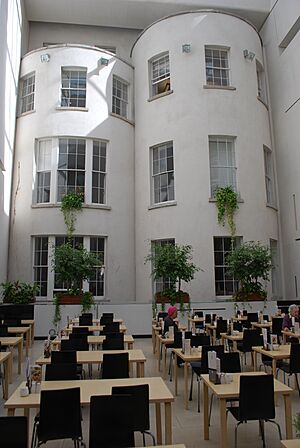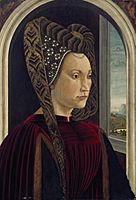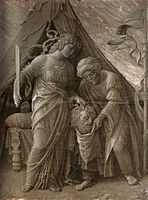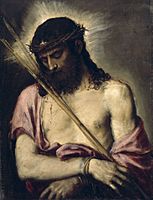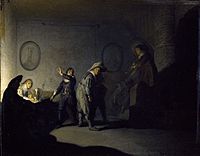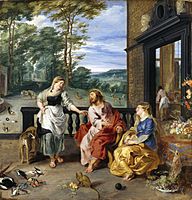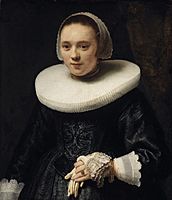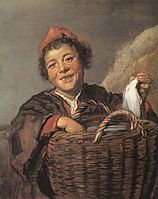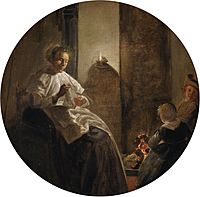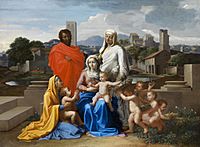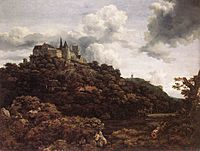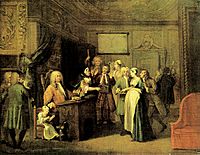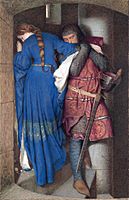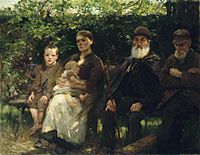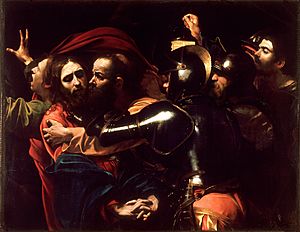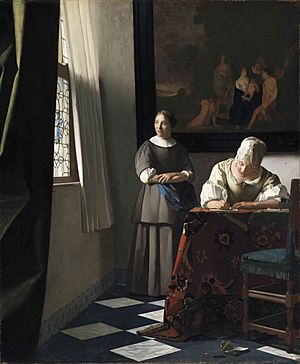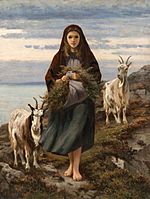National Gallery of Ireland facts for kids
| Gailearaí Náisiúnta na hÉireann | |
 |
|
| Established | 1864 |
|---|---|
| Location | Merrion Square West, Dublin, Ireland |
| Type | Art museum |
| Key holdings | Kitchen Maid with the Supper at Emmaus Portrait of Doña Antonia Zárate The Taking of Christ Lady Writing a Letter with her Maid Connemara Girl |
| Public transit access | Clare Street bus stop |
The National Gallery of Ireland (which is called Gailearaí Náisiúnta na hÉireann in Irish) is a special place in Dublin. It holds a huge collection of art from Ireland and other parts of Europe. You can find it right in the middle of Dublin city. One entrance is on Merrion Square, next to Leinster House, and another is on Clare Street. The gallery started in 1854 and opened its doors ten years later. It has many Irish paintings and is also famous for its Italian Baroque and Dutch masters artworks. The person in charge right now is Caroline Campbell.
Contents
History of the Gallery
In 1853, a big event called the Great Industrial Exhibition happened in Dublin. It was held on the lawns of Leinster House. A very popular part of this exhibition was a large display of art. This art show was put together by a railway boss named William Dargan. People loved seeing the art, and it showed that many people in Dublin really liked art.
Because of this, it was decided to create a permanent art collection for everyone to enjoy. This new gallery would also be a way to thank William Dargan. A lawyer named John Edward Pigot was a key person in making this idea happen. He became one of the first leaders of the gallery. The outside of the National Gallery looks similar to the Natural History building of the National Museum of Ireland. The gallery building was designed by Francis Fowke and opened in 1864.
When the gallery first opened, it only had 112 paintings. In 1866, the gallery started getting money each year to buy new art. By 1891, they already needed more space! In 1897, the Dowager Countess of Milltown decided to give many artworks from her home, Russborough House, to the gallery. This gift included about 223 paintings, sculptures, engravings, and other items. This big gift led to building a new part of the gallery, now called the Milltown Wing, which opened in 1903.
Around that time, an art collector named Henry Vaughan gave 31 watercolour paintings by J. M. W. Turner to the gallery. He had a special rule: they could only be shown in January. This was to protect them from bright sunlight. Even though modern lights are safer now, the gallery still shows these paintings only in January. It has become a special event each year.
Another important gift came from Hugh Lane (1875–1915). He was the director of the gallery in 1914. Sadly, he died when the Lusitania sank. He left a large collection of pictures to the gallery. He also left some of his money, which created the Lane Fund. This fund still helps the gallery buy new artworks today. Hugh Lane also wanted to start a gallery for modern art, which eventually happened after his death at the Hugh Lane Gallery.
The famous writer George Bernard Shaw also gave a lot of money to the gallery. He left them a third of the money from his books and plays. He did this to thank the gallery for the time he spent there when he was young.
The gallery grew again in 1962 with a new part designed by Frank DuBerry. This part opened in 1968 and is now called the Beit Wing. In 1978, the government gave the gallery paintings that Chester Beatty had given to the nation. In 1987, the Sweeney gift brought 14 artworks, including paintings by Picasso and Jack B. Yeats. In the same year, the gallery received more art from Russborough House. Alfred Beit donated 17 masterpieces, including paintings by famous artists like Velázquez and Vermeer.
In the 1990s, a lost painting by Caravaggio called The Taking of Christ was found. It was hanging in a Jesuit house in Dublin. A senior art expert from the gallery, Sergio Benedetti, discovered it. The Jesuits allowed this painting to be shown in the gallery, and its discovery caused great excitement across the country. The painting was even loaned to an Italian gallery for a few months in 2010. In 1997, Anne Yeats gave her uncle Jack Yeats's sketchbooks to the gallery. Now, the gallery has a special Yeats Museum. Denis Mahon, a well-known art expert, promised part of his large collection to the gallery. Eight paintings from his promised gift are always on display, including Jacob Blessing the Sons of Joseph by Guercino.
Gallery Directors
Here are some of the people who have led the National Gallery of Ireland:
- George Mulvany, 1861–1869
- Henry Doyle, 1869–1892
- Walter Armstrong, 1892–1914
- Hugh Lane, 1914–1915
- Walter G. Strickland, 1915–1916
- Robert Langton Douglas, 1916–1923
- Lucius O'Callaghan, 1923–1927
- Thomas Bodkin, 1927–1935
- George Furlong, 1935–1950
- Thomas McGreevy, 1950–1963
- James White, 1964–1980
- Homan Potterton, 1980–1988
- Raymond Keaveney, 1988–2012
- Sean Rainbird, 2013–2022
- Caroline Campbell, 2022–present
Millennium Wing
A new part of the gallery, called the Millennium Wing, opened in 2002. This new wing faces the street. The architects, Benson & Forsyth, designed it with a grand stone front and a large open space inside called an atrium. The original plan was to knock down a nearby old house, but the planning authorities said it had to stay.
Improving the Gallery
In March 2011, work began to fix and update the older parts of the gallery, the Dargan (1864) and Milltown (1903) wings. The first step was to replace the roof of the Dargan Wing. After that, they replaced the Milltown Wing roof. Then, they did a lot of work to improve the buildings and their systems, making them look like their original elegant selves. The renovation of these two wings was finished in June 2017.
Visiting the Gallery
The National Gallery of Ireland is in the heart of Georgian Dublin. You can enter from Merrion Square or Clare Street. It's free to get in, and many talks, tours, and events are also free. The gallery even launched a free smartphone app in 2013 to help visitors.
You can get to the gallery easily by public transport. Dublin Bus routes 4, 7, and 7a pass by. The Pearse Street DART station is only a 5-minute walk away. The Dawson stop on the green line of the Luas tram is also a 5-minute walk. There are also two dublinbikes stations right outside the gallery.
All parts of the gallery are easy to access for wheelchairs and buggies. There are special parking spots for disabled visitors near the Merrion Square entrance. Tours for people with sight or hearing difficulties are often available. Guide dogs are welcome inside the gallery. The lecture theatre, AV room, and shop have special systems to help people with hearing aids.
Artworks to See
The gallery has about 14,000 artworks! This includes around 2,500 oil paintings, 5,000 drawings, 5,000 prints, and some sculptures, furniture, and other art pieces.
-
Domenico Ghirlandaio, Presumed Portrait of Clarice Orsini, Wife of Lorenzo the Magnificent, before 1494
-
Andrea Mantegna, Judith, 1490s
-
Titian, Ecce Homo, 1558–60
-
Rembrandt, Interior with Figures, 1628
-
Jan Brueghel the Younger and Peter Paul Rubens, Christ in the House of Martha and Mary, 1628
-
Frans Hals, Fisher Boy, c 1630–32
-
Dirck Hals, A Woman Sewing by Candlelight, 1633
-
Nicolas Poussin, The Holy Family (Sainte Famille), c 1649
-
Jacob van Ruisdael, Burg Bentheim, 1653
-
Diego Velázquez, La mulata (La cena de Emaús), before 1660
-
William Hogarth, A Woman Swearing a Child to a Grave Citizen, c.1729
-
Frederic William Burton, The Meeting on the Turret Stairs, 1864
-
Walter Osborne, In a Dublin Park, Light and Shade, 1895
Art from Spain
- Diego Velázquez (1599–1660) Kitchen Maid with the Supper of Emmaus, c.1617–18
- Bartolomé Esteban Murillo (1617–82) The Return of the Prodigal Son c.1660
- Francisco José de Goya y Lucientes (1746–1828) Dona Antonia Zarate c.1805–06
- Pablo Ruiz Picasso (1881–1973) Still-Life with Mandolin 1924
Art from France
- Nicolas Poussin (1594–1665)
- Acis and Galatea 1627–28
- The Lamentation over the Dead Christ 1657–60
- Jean-Baptiste-Siméon Chardin (1699–1779) Still Life: Two Rabbits, a Grey Partridge, Game Bag and Powder Flask 1731
- Claude Monet (1840–1926) Argenteuil Basin with a Single Sailboat 1874
Art from Italy
- Fra Angelico (1417–55) Sts Cosmas and Damian and their Brothers surviving the Stake c.1440–42
- Titian (c.1485/90–1576) Ecce Homo c.1558/60
- Caravaggio (1571–1610) The Taking of Christ 1602
- Guercino (1591–1666) Jacob blessing the Sons of Jacob c.1620
- Canaletto (1697–1768) St. Mark's Square c.1756
Art from Germany and Switzerland
- Angelica Kauffman (1741–1807) The Ely Family 1771
Art from Flanders (Belgium)
- Pieter Brueghel the Younger (1564–c.1637) Peasant Wedding 1620
- Peter Paul Rubens (1577–1640) St Peter finding the Tribute Money 1617–18
- Anthony van Dyck (1599–1641) A Boy standing on a Terrace c.1623–24
Art from the Netherlands
- Rembrandt (1606–69) Landscape with the Rest on the Flight into Egypt 1647
- Jan Steen (1625/26–79)
- The Village School c.1665
- The Marriage Feast at Cana 1665–70
- Johannes Vermeer (1632–75) Lady Writing a Letter with her Maid c.1670
- Frans Hals Fisher boy with basket
Art from Britain and America
- William Hogarth (1697–1764) The Western Family c.1738
- Thomas Gainsborough (1727–88) The Cottage Girl 1785
- Joshua Reynolds (1723–92) Omai 1776 (On loan from a private collection)
- John Singer Sargent (1856–1925) The Bead Stringers of Venice 1880–82
Art from Ireland
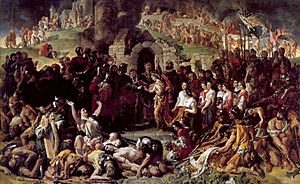
- James Barry (1741–1806) The Temptation of Adam 1767–70
- Augustus Nicholas Burke (1838–1891) Connemara Girl (1865).
- Daniel Maclise (1806–1870) The Marriage of Strongbow and Aoife, 1854
- Walter Osborne (1859–1903) Dublin Streets: a Vendor of Books, 1889
- Paul Henry (1876–1958) Launching the Currach 1910–11
- Louis le Brocquy (1916–2012) A Family 1951
The Yeats Collection
- Jack B. Yeats (1871–1957)
- The Liffey Swim 1923
- A Morning in a City 1937
- John Butler Yeats (1839–1922) John O'Leary 1904
Drawings and Watercolours
- Joseph Mallord William Turner (1775–1851)
- A Ship against the Mewstone, at the Entrance to Plymouth Sound
- Frederick William Burton (1816–1900) Hellelil and Hildebrand, the Meeting on Turret Stairs, 1864 1864
- Edgar Degas (1834–1917) Two Ballet Dancers in a Dressing Room
- Pablo Ruiz Picasso (1881–1973) Two Dancers 1925
Zurich Portrait Prize
The Zurich Portrait Prize is an art competition where artists create portraits. Artists who are citizens of Ireland or Irish citizens living abroad can enter. The winner gets €15,000 and a €5,000 payment to create a new portrait for the gallery.
Here are some past winners:
- 2018 Mandy O'Neill
- 2019 Enda Bowe
- 2020 Aidan Crotty
- 2021 Salvatore of Lucan
- 2022 David Booth
- 2023 Ruaidhrí Condon
Before it was called the Zurich Portrait Prize, it was the Hennessy Portrait Prize. Here are those winners:
- 2014 Nick Miller
- 2015 Vera Klute
- 2016 Gerry Davis
- 2017 Jack Hickey
Library and Archives
The library and archives at the National Gallery of Ireland have very special collections. These collections are important for studying art history. They started when the gallery was founded over 160 years ago. These collections cover art from ancient times to today. They are a key part of the National Collection. The library and archive have grown thanks to public funding and generous gifts from people.
The library is open to everyone. It has many books and documents about Western European art from the Middle Ages onwards. The collections about Irish and Italian art are especially large. There are over 100,000 books and many important historical records.
See also
 In Spanish: Galería Nacional de Irlanda para niños
In Spanish: Galería Nacional de Irlanda para niños
- List of national galleries



